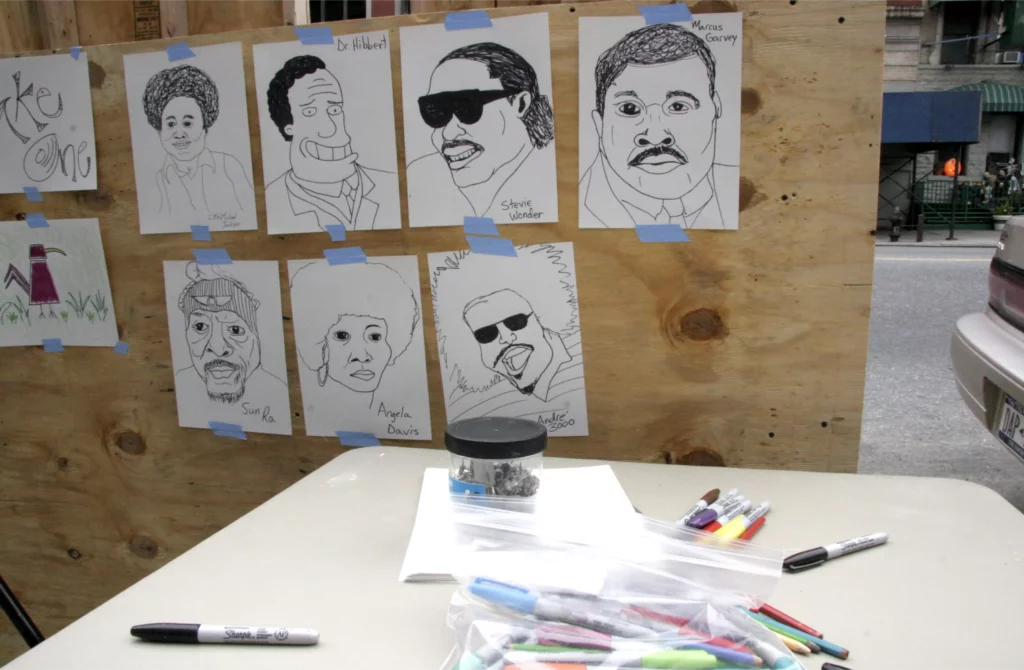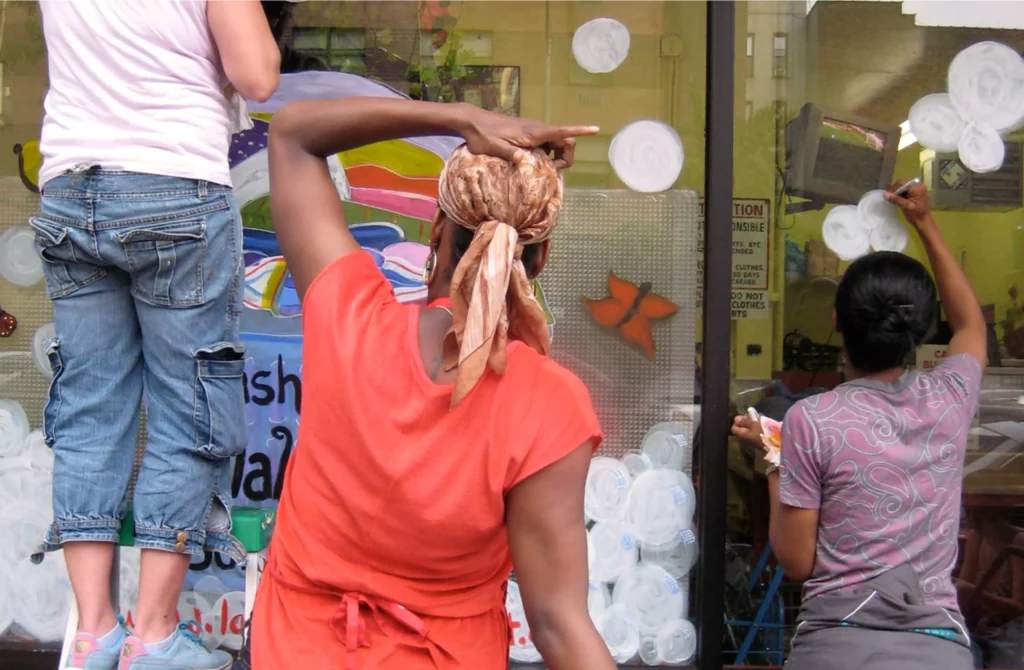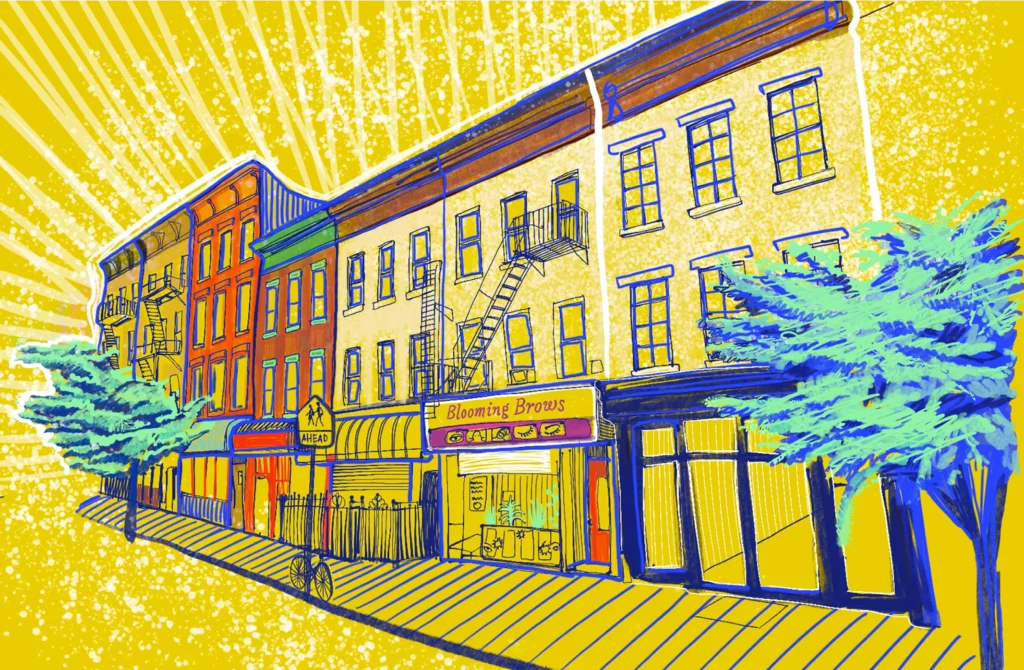The Laundromat Project (The LP) was incorporated in 2005 to make art accessible and relevant in New York City neighborhoods where people of color reside.
Our roots reach back to 1999, when The LP founder, Bed-Stuy resident Risë Wilson, left the corporate sector to build a life around art and community service.
Risë’s original idea for The Laundromat Project was to meet people where they already were and use art as a tool for turning strangers into neighbors. A belief in creativity as a powerful means of self-determination—and a keen desire to redraw the lines between art maker and art consumer, art as luxury and art as necessity—led Risë to the laundromat: “No matter what was happening in the economy, people had to do their laundry, and this was a kind of de facto public space.”
The idea of a laundromat as a primary place for engagement has expanded over time. It now serves as a metaphor for a variety of settings in which artists and neighbors transform their lives and surroundings. Our programming has evolved to take place in community gardens, public plazas, local cultural organizations, and other places where people gather.
1999: The Vision
Risë Wilson first dreams up The Laundromat Project as a vehicle for bringing art to spaces where community members already gather.

2005: Official Incorporation
The LP is incorporated by Risë Wilson and the founding board, including Alea Woodlee and Dawn Strickland. The LP receives its first funding via the Echoing Green Fellowship and a grant from the Brooklyn Arts Council. Risë’s goal is to eventually purchase and operate a real laundromat that will host arts programming
The first public LP art program, a fabric mural workshop, takes place at the Stuyvesant Heights Senior Center in Bed-Stuy, facilitated by Risë
2006: Beginning of Create Change Program
The board expands and is joined by present-day ED Kemi Ilesanmi. Rudy Shepherd, Shinique Smith, and Miriam Neptune become The LP’s first Create Change Artists-in-Residence, staging projects in existing laundromats throughout NYC.

2008: Responding to Crisis
The Financial Crisis hits, making the purchase of a laundromat ever more difficult. The board suspends the Create Change program for one year to recalibrate.

2009: Expansion of Program
The Create Change program returns, with projects taking place in laundromats in Bed-Stuy and Harlem. The LP also launches its Community Arts Education program in Harlem, a series of artmaking workshops at laundromats. Petrushka Bazin Larsen is hired as The LP’s first staff member, becoming an early and integral part of The LP’s programming.

2010: 501(c)3 Status
The LP officially becomes a 501(c)3 nonprofit organization.
2011: Kemi Ilesanmi Becomes Inaugural ED
After 5 years offering the Create Change residency, The LP adds a fellowship program for artists looking to develop or deepen their community engagement practice. Kemi Ilesanmi joins The LP as the first full-time and paid Executive Director. Risë Wilson becomes Board Chair.

2013: Field Day
The LP completes its first full strategic plan with Yancey Consulting, and identifies three “anchor neighborhoods” for sustained programmatic focus: Bed-Stuy, Harlem, and Hunts Point/Longwood. The inaugural Field Day—a daylong activation of Create Change artist projects—takes place across the three neighborhoods, happening annually through 2017.

2014: Kelly Street Collaborative
The LP collaborates with Kelly Street Garden, Banana Kelly, and Workforce Housing to transform a two-bedroom apartment in the Hunts Point/Longwood neighborhood of the Bronx into a community art space: the Kelly Street Collaborative, or KSC.

2018: Strategic Visioning
The LP begins a community-engaged strategic visioning process in partnership with Buscada.
2019: The Search For A Long-Term Home
The LP launches a new strategic vision to carry it forward through at least 2022. With great care and community engagement, The LP bids farewell to its Kelly Street space while setting intentions to bring its programmatic and administrative operations under the same roof. The organization holds multiple community listening sessions to determine where our new home should be.

2020: Bed-Stuy!
The LP finds a perfect space in Bed-Stuy, Brooklyn, signing a 10-year lease the same week that the COVID-19 pandemic shuts down New York City! While the move can’t happen exactly as planned, The LP is able to begin its community engagement process and share the news.
